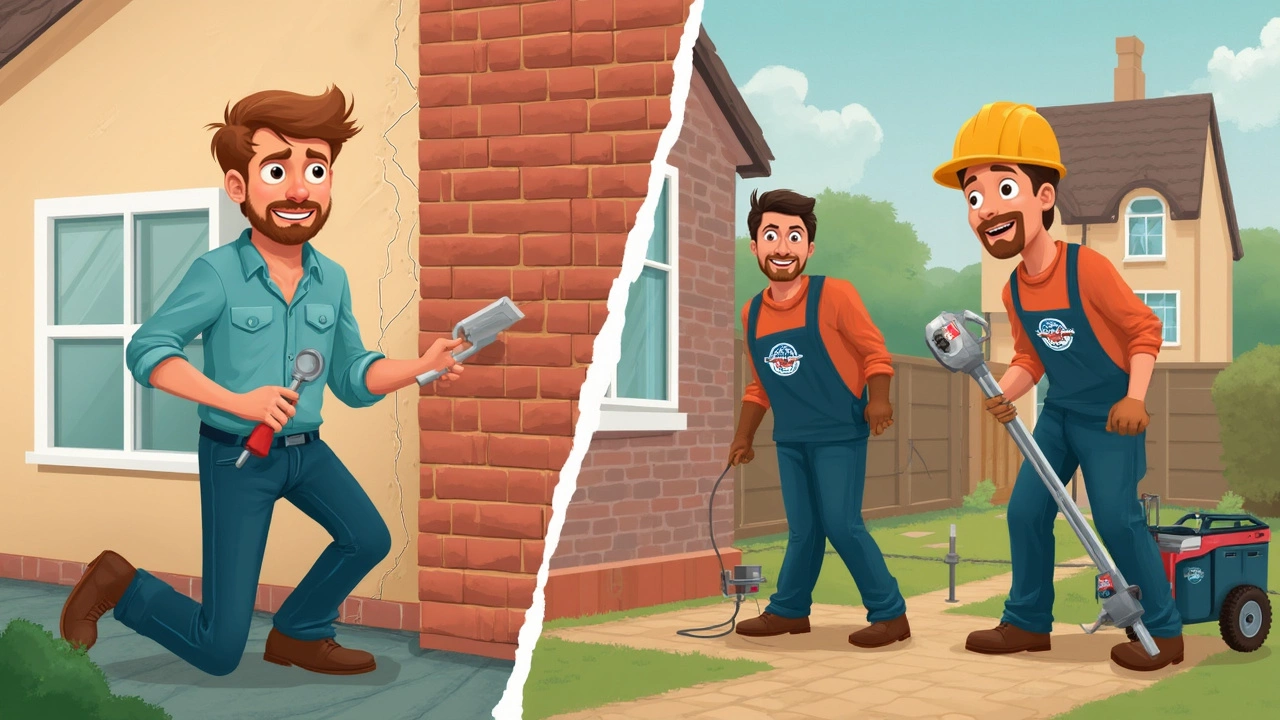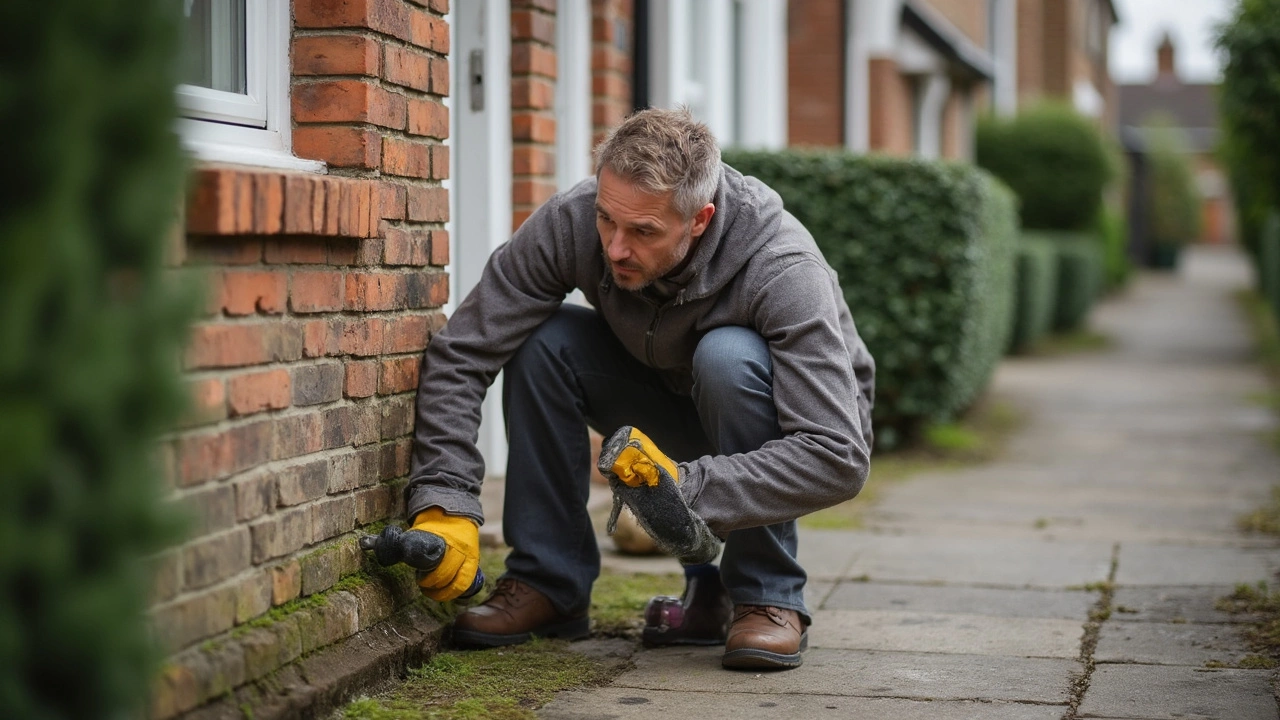If you’re staring at a crack in your basement wall or sloping floors and wondering if you can fix your foundation yourself, you’re not alone. The internet is full of videos showing guys slapping hydraulic cement on a crack, but what actually works in real life and what’s a quick way to burn cash and waste your weekend?
Some smaller issues—like thin, hairline cracks or slightly uneven floors—might seem like a DIY dream. And sometimes, they actually are. Small cracks from settling? These can often be sealed with epoxy or polyurethane kits from your local hardware store. But not all cracks mean the same thing. When you see big gaps, doors that don’t shut, or windows jamming, you’re probably looking at deeper trouble—and that’s not something you should just YouTube your way through.
Before you do anything, grab a flashlight and look for clear warning signs: deep or widening wall cracks, uneven floors that feel like a funhouse, doors or windows that used to work but are now stuck. If the crack is wide enough to fit a coin, that’s a red flag. Vertical cracks from top to bottom or horizontal ones are even bigger worries. These could mean real movement underneath your house.
- Spotting Foundation Problems: What Counts as Serious
- DIY Foundation Fixes: What’s Actually Possible
- When to Call a Pro (and Why DIY Can Go Wrong)
- Cost, Tools, and Safety: Real-Life Tips
Spotting Foundation Problems: What Counts as Serious
If you’re worried about your place shifting or settling in a weird way, you’ve got to start with the basics: knowing what’s just normal aging and what actually spells trouble. Not all cracks or weird spots on your wall are a call for panic. But some signs are, well, kind of terrifying.
The first thing to look for are cracks. Hairline cracks—those pencil-thin ones running vertically—are usually just the natural settling of your house, especially if you see them after a season of rain or drought. These are usually harmless and just need to be sealed up. The ones you shouldn’t ignore are:
- Horizontal cracks across your basement or crawl space walls (these can mean pressure from soil outside).
- Stair-step cracks in brick or block walls, especially near corners.
- Cracks that are wider than a quarter-inch or seem to keep growing over time.
You also want to watch for flooring problems. If you notice spots that suddenly feel sloped, or you find a marble rolling across the room by itself, it’s time to pay attention. Sometimes, uneven floors are as much a warning of foundation repair needs as the cracks in your wall.
Doors and windows are another giveaway. If they used to close perfectly but now seem stubborn, especially on the first floor, that’s typically a sign the foundation has shifted. And if you’re seeing gaps around window frames or your molding is pulling away from the walls, don’t brush it off as bad carpentry—those gaps are legit signs of real movement below.
Want to know how common these problems are? Check out this snapshot of foundation issues reported in U.S. homes:
| Problem | % of Homes Affected |
|---|---|
| Hairline Cracks | 60% |
| Horizontal/Structural Cracks | 18% |
| Sloping Floors | 22% |
| Sticking Doors/Windows | 28% |
Some of these are more serious than others, but anything beyond basic settling should make you pause before going full DIY foundation mode. Ignoring or patching over real structural problems can mean spending a fortune down the road.
DIY Foundation Fixes: What’s Actually Possible
Let’s get real—DIY foundation repair isn’t a magic solution, but there are some things you can handle yourself if the problems are small and don’t scream “call a contractor.”
The most doable fixes revolve around minor cracks, tiny leaks, and simple preventive steps. If you’ve got hairline cracks (the kind you can barely fit a fingernail in), you can tackle these using store-bought epoxy or polyurethane crack injection kits. Follow the basic steps:
- Clean the crack so it’s dust-free and dry—use a wire brush if you need to.
- Mix the resin or the sealant according to the instructions.
- Apply the injection ports if your kit has them, then fill the crack slowly to make sure it seals up the whole line.
- Let it cure fully before painting over it or moving anything back into place.
Waterproofing is another common DIY move. Basic waterproofing paints or sealers for the inside of your basement walls can help with minor, non-structural water seepage. Don’t confuse this with real fixing, though—it’s more of a quick patch than a real repair.
If your foundation shows mild settling, like a concrete slab that’s sunk a bit but isn’t cracking apart, you might try mudjacking or slabjacking kits, but these require some skill and the right tools. Honestly, anything more complicated than slapping sealant in a crack is easy to mess up and could make things worse.
Here’s a quick breakdown of what works and what probably won’t with DIY foundation jobs:
- Works: Hairline crack injections, applying waterproof paint, clearing gutters and downspouts to move water away from the foundation.
- Won’t work: Restraining or lifting a settling foundation, fixing bulging basement walls, or addressing wide cracks (wider than 1/4 inch).
If you’re curious, about 80% of foundation repairs done by professionals are more complex than what the average homeowner can safely handle at home. Getting your hands dirty is great for small stuff, but don’t let online videos fool you into thinking you can handle real foundation repair projects without headaches—or risk.
| DIY Task | Skill Level | Success Rate |
|---|---|---|
| Hairline Crack Repair | Easy | High (if cracks are not structural) |
| Waterproof Paint | Easy | Moderate |
| Mudjacking | Challenging | Low (for inexperienced DIYers) |
| Major Wall Movement | Advanced | Very Low—call a pro |
Sticking to small repairs isn't just safer—it's usually a lot more effective and will help you prevent bigger headaches later.

When to Call a Pro (and Why DIY Can Go Wrong)
This is where reality hits: foundation repair isn’t always a weekend project. Sometimes, grabbing that crack filler leads to bigger expenses and headaches down the road. If you see big cracks wider than a pencil, large uneven areas, or your walls bowing, you need a seasoned pro. Foundation movement that keeps getting worse, sinking corners, gaps you can stick your finger in—these are all stop signs for the DIY crowd.
Here’s a quick breakdown of what needs immediate professional help:
- Horizontal cracks in basement or crawlspace walls
- Sloping floors that seem to get worse over time
- Stuck doors or windows in several rooms
- Cracks that keep reopening after you patch them
- Water seeping through foundation walls
Trying to DIY these problems with patch materials or store-bought fixes can actually mask more serious structural issues. You end up with a prettier crack, but the problem keeps chewing away underneath. According to the International Association of Certified Home Inspectors, “Only a structural engineer or experienced foundation specialist has the training to judge what caused the damage and the safest path to fix it.”
A leading home inspector says, “One of the most common homeowner mistakes is thinking that sealing over a crack is the same as solving the foundation’s root problem. Sometimes, you just can’t see what’s really moving below ground.”
And the risks aren’t minor. Messing up foundation work can tank your home’s value, raise your insurance rates, or even make your house unsafe. If you need permits or you plan on selling, pros are the only choice—most cities need licensed specialists to sign off on repairs. A 2023 survey found that homes with unpermitted DIY foundation repair can lose up to 15% of their value compared to homes fixed by pros. If you’re worried about cost, ask for multiple quotes. Many companies will inspect for free, so you at least know what you’re dealing with.
| DIY Attempt | Common Result | Pro Fix |
|---|---|---|
| Surface patching | Crack reopens, water still seeps in | Structural epoxy, waterproofing |
| Extra concrete | Added weight, more shifting | Piers, anchors, grading fixes |
| Ignore minor leaks | Mold, wall crumbling months later | Proper drainage, wall stabilization |
Bottom line: if the problem looks big, keeps getting worse, or gets you worried, bring in the experts. You’ll save money and headaches in the long run—and avoid the kind of mistakes that can haunt you for years.
Cost, Tools, and Safety: Real-Life Tips
Tackling foundation repair by yourself comes with a price tag—not just in cash, but in time and sweat, too. For minor patch jobs, like sealing a small crack with a kit, expect to spend about $30 to $50. These kits usually come with everything you need: sealant, an applicator, and maybe a mixing tool. But if your crack needs reinforcement, like carbon fiber straps or hydraulic cement, that budget jumps fast—think $300 and up.
| DIY Foundation Repair Item | Average Cost (USD) |
|---|---|
| Epoxy Crack Kit | $40-$60 |
| Hydraulic Cement | $20-$40 (per bag) |
| Carbon Fiber Strap Kit | $350-$500 |
| Jack Posts | $100-$300 each |
The list of tools isn’t super fancy, but you do need the right stuff. Here’s what usually ends up in most garages if you try this: safety goggles, gloves, hammer, chisel, putty knife, and a caulking gun. And don’t forget a stiff brush for cleaning cracks—dust and gunk wreck your repairs right from the start.
Now, about safety—this is where a lot of DIYers get tripped up. Concrete dust can mess with your lungs, so wear a mask. Safety goggles aren’t optional when you’re chipping or mixing. If you’re working in a crawlspace, a headlamp and some knee pads come in handy. But here’s the big one: never try to lift or shift heavy things without support. Jacking up part of your house is risky and needs proper equipment—if you use the wrong jack, or set it on soft ground, the house can slip. That’s a scary thought.
- Use only tools made for concrete work—cheap tools can snap or fail fast.
- Read all labels on sealants and mixes—some chemicals need ventilation.
- Don’t skip gloves; cement can burn your skin.
- Never try to fix a load-bearing wall by yourself—this needs a pro.
If you’re tempted to save money, remember that quick fixes on serious home repair problems usually cost even more down the line. If you have doubts, it’s smart (and safer) to call a foundation expert for a quote—lots of companies will do quick inspections for free.
